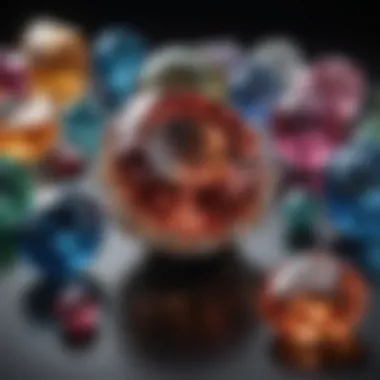Exploring the International Gems Show: A Comprehensive Guide


Intro
The allure of gemstones stretches far beyond their aesthetic appeal; they embody history, culture, and artistry that have captivated humanity for centuries. The International Gems Show serves as a central hub for exploring these treasures, bringing together a diverse array of enthusiasts, collectors, and traders. Whether one is a novice keen on learning about gemstones or a seasoned collector on the lookout for rare finds, this guide aims to provide a detailed examination of everything one can expect from the show.
Understanding the facets of gemstones—from their classification to their historical significance—can enrich both the experience at such events and the appreciation of these natural wonders. This narrative will delve deeper into the distinctions among various types of gemstones, investigate their past, and touch on how they continue to shape cultures worldwide. Moreover, we will explore the economic implications of the show, helping to illuminate trends that emerge within the changing landscape of the gem industry.
Gemstone Overview
Definition of Gemstones
Gemstones are naturally occurring minerals, rocks, or organic materials that can be cut and polished for decoration. They are typically classified based on their rarity, beauty, and physical properties. A gemstone’s value often hinges on the four Cs: carat, cut, color, and clarity. However, there are additional factors that contribute to the worth of a gemstone, including its origin, the conditions under which it formed, and its historical significance.
Classification of Gemstones
Gemstones can be broadly classified into two categories: precious and semi-precious. This classification can help buyers discern value at a glance:
- Precious Gemstones: These include diamonds, rubies, sapphires, and emeralds. They are highly sought after due to their rarity and exquisite beauty.
- Semi-Precious Gemstones: This category includes a wide variety of stones such as amethyst, garnet, and aquamarine. While these gemstones are often less expensive than their precious counterparts, they can still offer striking beauty and unique characteristics.
Furthermore, each gemstone possesses specific traits that distinguish it from others:
- Organic Gemstones: Includes pearls and amber, formed through biological processes.
- Inorganic Gemstones: Formed from geological processes, like quartz or opal.
The classification not only guides collectors but also plays a significant role in the market dynamics, influencing buying trends at events like the International Gems Show.
Historical Significance
Origins of Gemstone Use
The history of gemstones is woven into the fabric of human civilization. From ancient times, tools made from gemstones were revered, believed to possess healing properties or evoke divine favor.
Historians trace the use of gemstones back to ancient Egyptian times when they adorned the graves of pharaohs. The rich colors of lapis lazuli, turquoise, and garnet told stories of opulence and power, firmly embedding these stones in cultural lore. Even in regions like Mesopotamia and the Indus Valley, precious stones were integral to royal adornments and trade.
Cultural Insights: Gemstones in Ancient Civilizations
- Babylonia: Known for the widespread use of lapis lazuli and carnelian, these gems were symbols of personal wealth.
- Ancient Egypt: Gemstones such as turquoise and malachite held religious significance, often used in amulets to ward off evil.
- India: Historically renowned for its diamond mines, India has a rich history of jade and ruby adornments in royal courts.
Gemstones continue to serve as cultural symbols, reflecting the values and beliefs of societies throughout history. Their ongoing significance is evident at the International Gems Show, where ancient traditions meet modern trends. The passion shared among collectors and enthusiasts is reminiscent of those early days, a testament to the timeless appeal of these dazzling natural resources.
"Gemstones are the reminder that beauty can emerge from the rough, just as human experiences shape us into who we are."
As we delve deeper into the International Gems Show, we will explore not just the stones themselves, but the rich tapestry of history and culture surrounding them, enhancing our understanding of their place in our world today.
The Importance of Gem Shows
Gem shows are pivotal events that serve not only the commercial interests within the gemstone market but also foster a vibrant community that celebrates the beauty and complexity of these natural wonders. They are platforms where enthusiasts, collectors, traders, and the curious alike come together, allowing for a rich exchange of knowledge and passion for gemstones. A gem show allows attendees to discover, appreciate, and contribute to the evolving landscape of the gemstone industry.
Historical Context
The roots of gem shows can be traced back several decades, where small gatherings began in local venues. These initially humble exhibitions gradually gained momentum, leading to larger, more organized international events. For instance, the Tucson Gem and Mineral Show, known as one of the oldest and largest gem shows in the world, began in 1955, reflecting a growing curiosity and demand for gemstones and minerals. This historical context underlines not just the evolution of the shows but also their significance in shaping the global awareness of gemstone diversity.
The tradition of gathering to showcase precious and semi-precious gemstones provides a sense of continuity rooted in both culture and commerce. Over the years, the functions of these shows expanded beyond mere displays—traders began to see them as vital opportunities to forge business relationships. Consequently, gem shows have fostered an environment where the latest discoveries, trends, and practices can be highlighted.
Economic Significance
Economically, gem shows are like gold mines, benefiting not only the participants but also the surrounding communities. The influx of visitors generates substantial revenue through hotel bookings, dining, transportation, and more. Participants often come from various parts of the globe, eager to buy and sell gems. This boosts local economies, especially in cities known for hosting international shows.
Moreover, the visibility garnered from these events can spark trends in the gemstone industry, influencing pricing and availability. For instance, if a previously overlooked stone catches the attention of designers and jewelers at a show, its market demand might surge, leading to a higher price point in subsequent years. The interconnectedness of these markets is crucial for understanding how gem shows contribute to economic cycles.
Cultural Impacts
On a cultural note, gem shows have a way of encouraging appreciation for the artistic and symbolic values of gemstones. Countries have their own cultural significances tied to specific gemstones—like the deep red ruby in Burma or the vibrant turquoise in Native American cultures. Attending a gem show can open the door to exploring these stories, connecting individuals through their heritage and the common love for gemstones.
Furthermore, gem shows offer a space for shared interests and community formation. Many attendees are not just passive viewers; they are active participants who engage in dialogues about mining practices, cutting techniques, and metaphysical properties of stones. This communal atmosphere cultivates a deeper understanding and respect for the gem world, showcasing its multifaceted nature.
"Gem shows are not merely markets; they are where stories and cultures intersect, transforming gems into important symbols of beauty, value, and community."
In summary, the importance of gem shows extends far beyond transactions. They serve as vibrant ecosystems that support economic growth, cultural exchange, and historical awareness of gemstones' enduring allure.


Overview of the International Gems Show
The International Gems Show serves as a vital cornerstone for anyone with an interest in the world of gemstones and jewelry. It's more than just a venue for buying and selling; it encapsulates a journey through varied cultures, historical contexts, and economic implications. The show does not merely showcase gems but amplifies their stories and the skills that shape them. Understanding this event is crucial for enthusiasts, collectors, and industry professionals alike. Here, we break it down further.
Location and Dates
The venue and timing play a significant role in shaping the experience at the International Gems Show. Typically held in sprawling convention centers in global cities - such as Tucson, Arizona, or Hong Kong - the location facilities not just the gathering of stones but the meeting of minds. With different chambers dedicated to specific regions and specialties, it’s like walking through various landscapes of the earth. Visitors can expect the show to take place annually during winter months, often strategically timed to catch holiday shopping and its associated buzz.
The vastness of the venue allows for an immersive experience. There are often signages indicating different sections, helping visitors navigate through countless stalls.
Participating Countries
The international aspect of the show is one of its most exciting features. Countries from around the globe contribute to the showcase, each bringing their own flair and expertise. Think of Afghanistan with its stunning lapis lazuli or Brazil renowned for its vibrant amethysts. This cultural cocktail not only enriches the selection of gems available but also enhances the dialogue amongst traders and collectors about techniques, traditions, and market demands.
Attendees will likely find exhibitors from the USA, India, Thailand, and many other countries, making the International Gems Show a melting pot of talent. Networking opportunities arise naturally here, as industry insiders can exchange insights over fine stones while learning about local challenges and successes.
Visitor Demographics
Understanding who visits the International Gems Show adds another layer to the event's significance. The attendee pool is incredibly diverse, encompassing hardcore gem aficionados, novice collectors, curious tourists, and professional jewelry designers. It's like a vibrant tapestry woven from different threads of knowledge and experience.
- Gem Enthusiasts: They come eager to discover new stones and connect with specialists.
- Collecters: Often on the hunt for unique pieces that fit into their existing collection.
- Jewelry Designers: They are looking for inspiration and materials to incorporate into their upcoming projects.
- Geology Buffs: Many visitors are simply fascinated by the Earth’s treasures and enjoy understanding their origins.
This mix creates a dynamic atmosphere, encouraging conversations filled with passion and curiosity about gems, mining practices, and design trends. It's not merely business; it’s a celebration of a shared love for these natural marvels.
The International Gems Show acts as both a marketplace and meeting ground, fostering connections across cultures and generations.
In considering these elements for the overview of the International Gems Show, it becomes apparent that participation in such an event offers benefits far beyond being just a spectator. Attendees engage, learn, and expand their horizons, making it a not-to-miss experience for anyone with a vested interest in gems and jewelry.
Categories of Gems on Display
Gems are not just shiny stones; they hold stories, meanings, and a certain allure that captivates enthusiasts and collectors alike. Within the context of the International Gems Show, understanding the categories of gems on display is paramount. Each category, whether precious, semi-precious, or rare, carries with it unique characteristics and values. The significance lies in the diversity of these gems, as they appeal to a varied audience and bring in both aesthetic and monetary considerations.
Precious Gems
When we talk about precious gems, our minds typically jump to the big three: diamonds, rubies, and emeralds. These stones are heavier hitters not only for their beauty but also for their rarity. Take diamonds, for instance. Known for their exceptional hardness, they symbolize love and commitment. But beyond their symbolism, their ideal cut, color, clarity, and carat weight determine their worth. Similarly, rubies, with their intense red hue, are often seen as symbols of passion and vitality.
Investing in precious gems has long been viewed as a way to not just adorn oneself but to hold tangible assets. The market for these stones can shift dramatically, influenced by trends and supply chains. Collectors often find themselves keeping a keen eye on auction houses, as high-quality gemstones can sometimes sell for millions in just a matter of moments. Hence, knowing these gems well is crucial for anyone serious about their collection.
Semi-Precious Gems
Turning our gaze to semi-precious gems, we find a more colorful and diverse array of stones. Think amethyst, aquamarine, and citrine. Each carries its unique charm and lore. While these gems may not have the same price tags as their precious counterparts, they are no less enchanting.
Semi-precious stones often attract newcomers to the hobby. The entry cost to collecting them is significantly lower, and their variety allows collectors to curate stunning displays that can highlight numerous colors and shapes. For example, amethyst’s violet hues and citrine’s warm tones provide a visual feast. The accessibility of these gems also opens the door to innovative designs in jewelry, making them favorites among new designers.
"Semi-precious stones are not just affordable alternatives; they can also shine just as bright and tell their own stories."
Rare and Collectible Stones
Then, there exist the rare and collectible stones, which transcend the definitions of precious and semi-precious. Imagine a black opal, a stone so elusive that only a few places on Earth yield it. These gems can be a gamble, as their worth can skyrocket based on market demand and rarity. Collectors often hunt down these unique pieces not just for personal enjoyment, but also as savvy investments.
With stones like tanzanite or painite—considered one of the rarest minerals on Earth—the allure lies in their scarcity. They often have captivating backstories, explaining how they were discovered or why they are limited in availability. Adding such collectible gems to one's collection can elevate the overall value as well as provide bragging rights among fellow enthusiasts. Collectors commonly engage in rigorous research to verify provenance and understand market trends, making knowledge and networking key components in their pursuits.
Showcase of Jewelry and Craftsmanship
The showcase of jewelry and craftsmanship at the International Gems Show is more than just a collection of sparkling items; it is a celebration of artistry, innovation, and culture. This vibrant display draws in a diverse audience, from seasoned collectors to curious novices alike. Participants come eager to explore how jewelry can represent personal stories, cultural heritage, and unique artistic expressions. By engaging with this multifaceted assemblage of craftsmanship, attendees not only gain insights into the technical aspects of jewelry making but also witness the blur between art and functionality, setting the tone for emerging trends in the market.
Artisan Jewelry Makers
Artisan jewelry makers play a pivotal role in the ecosystem of the International Gems Show. Their work is often characterized by meticulous attention to detail and a commitment to authenticity that mass-produced items simply cannot match. Each piece crafted by these artisans carries a story—be it influenced by local traditions, personal experiences, or contemporary trends.
For instance, visiting the booth of a local artisan who specializes in turquoise and silver from the Southwestern U.S. can provide a glimpse into their creative process, offering nuggets of knowledge about the materials' sourcing and the cultural significance tied to them.
- Benefits of interacting with artisans:
- Understand the craftsmanship: Learn about methods and materials used in their creations
- Purchase unique pieces: Find items not available in conventional markets
- Support local economies: Buy from craftsmen whose livelihoods depend on their trade
Through these personal connections, attendees not only enrich their understanding but also contribute to the sustainability of these art forms.
Innovative Design Trends


While the traditional charm of artisan craftsmanship is compelling, the International Gems Show also serves as a platform for innovative design trends. Each year, visitors experience shifts in style that reflect broader societal movements, technological advances, and evolving consumer preferences.
For example, biomimicry designs—inspired by nature—have gained considerable traction, resulting in unique forms that mimic organic shapes found in plants and animals. This approach not only adds an aesthetic dimension but encourages a dialogue on the intersection of environmental sustainability and fashion. Here are a few notable trends:
- Minimalism: Focuses on sleek lines and understated elegance.
- Art Deco Revival: A resurgence of geometrical patterns and bold colors.
- Fusion Styles: Combining elements from different cultural backgrounds.
Attendees frequently find themselves influenced by these fresh perspectives, leading to comprehending what drives current tastes in the jewelry market.
Sustainable Practices in Jewelry Design
In an age where consumers are more conscious than ever about their choices, the International Gems Show highlights the importance of sustainable practices in jewelry design. Sustainable jewelry production aims to reduce negative impacts on the planet while promoting ethical sourcing of materials. This approach not only aligns with the values of discerning buyers but also fosters broader systemic changes in the industry.
- Ethical Sourcing: Many jewelers now source diamonds and gemstones from conflict-free zones, ensuring that the acquisition of these materials does not contribute to human rights abuses.
- Eco-Friendly Materials: The use of recycled metals and lab-grown gems minimizes the ecological footprint of jewelry production.
- Transparency: Increasingly, artisans are willing to share their sourcing practices and production methods, which can enhance consumer trust.
This focus on sustainability is helping reshape consumer expectations, influencing production practices across the industry.
"We can't just be in the business of selling pretty stones; we have to ensure we're doing so in a way that honors both the Earth and the communities involved in this craft."
Navigating the Show: Tips for Attendees
Navigating the International Gems Show can be akin to finding your way through a maze made from dazzling gemstones. Whether you’re a seasoned collector or just dipping your toes into the world of gems, having a solid plan equips you to get the most from the experience. Below, we delve into three essential aspects of navigating the show: planning your visit, understanding pricing structures, and networking opportunities. Each of these elements holds significance to ensure your journey is both fruitful and enjoyable.
Planning Your Visit
Preparation is key when it comes to making the most of your time at the show, and planning your visit should be the first item on your to-do list. Begin by checking the show’s official website for the latest information on dates, location, and entry fees. It’s crucial to familiarize yourself with the layout of the venue, as gem shows can be sprawling, featuring a mix of booths from various dealers and artisans.
- Set a Schedule: Look at the exhibitor list in advance. Identify the vendors and types of gems you're most interested in. This will help you prioritize your time. It might not be feasible to see everything, but knowing where to go can save you from feeling scattered.
- Make Note of Seminars and Workshops: Often, gem shows offer educational sessions that cover topics like gem identification, market trends, and design techniques. Attending these not only enriches your knowledge but also keeps you engaged.
- Consider Accommodation and Transport: If you're traveling from afar, planning your lodging options ahead of time is smart. Staying nearby alleviates stress on the day of the show, letting you enjoy a leisurely morning before diving into the excitement.
Understanding Pricing Structures
Another crucial aspect of navigating the show is getting a grip on pricing structures. Gem pricing can often feel like trying to decipher a foreign language, with factors like market demand, quality, and rarity playing a significant role.
- Get Acquainted with Key Terms: Familiarizing yourself with terms such as ‘carat weight,’ ‘clarity,’ and ‘color grade’ is beneficial. The more you know, the better chance you have to score a deal or understand value.
- Bargaining is Common: While some vendors display fixed prices, many are open to negotiation. Approaching a dealer with a friendly demeanor can lead to discounts or deals that may not be advertised.
- Consider the Total Cost of Ownership: Look beyond the sticker price. It's essential to think about any additional costs, like setting fees for loose stones or post-purchase appraisal costs if you're investing.
Networking Opportunities
Gem shows are not just about the stones; they’re also social gatherings that present invaluable networking opportunities. By establishing connections within the community, you pave the way for future transactions and collaborations.
- Engage with Vendors and Artists: Don’t hesitate to introduce yourself to vendors. Ask questions about their merchandise and share your interests. To them, the show is just as much about making connections as it is about sales.
- Participate in Group Discussions: Many attendees share a passion for gemstones. Join discussions to exchange knowledge and experiences, which can lead to friendships and partnerships.
- Leverage Online Platforms: After the show, continue conversations via social media or platforms like Reddit or Facebook. This helps maintain the connections you made, ensuring you stay in the loop regarding future events and opportunities.
"The connections and friendships formed at shows often become just as cherished as the gems themselves."
Navigating the gems show can be an exciting but daunting task. With planning, a clear understanding of pricing, and seizing networking opportunities, you can ensure your journey through the dazzling world of gems is memorable and rewarding.
Economic Trends in the Gemstone Market
Understanding the economic trends within the gemstone market is essential for anyone delving into the world of gems, whether you're a collector, trader, or simply an enthusiast. The dynamics of this market reveal not only the value associated with gemstones but also the influences shaping their availability and desirability. Analyzing trends helps stakeholders make informed decisions and adapt to the changing landscape of this vibrant industry.
Market Analysis
In recent years, the gemstone market has experienced fluctuations that mirror broader economic conditions. Key factors driving these changes include shifts in consumer preferences, global economic turmoil, and advancements in online trading platforms. Notably, the demand for ethically sourced gems has surged, netting a higher priority among buyers. This heightened awareness often translates into consumers willing to pay a premium for stones traceable to sustainable mines.
- Global Trends: The rise of e-commerce has revolutionized gemstone trading, leading to an increased supply of gems from lesser-known sources. Countries like Mozambique and Afghanistan have begun to emerge as significant players due to their rare offerings.
- Consumer Preferences: Millennial and Gen Z buyers are particularly focused on the backstory of their purchases, seeking gems with an ethical lineage. This trend reshapes the strategies of sellers who must demonstrate transparency in their sourcing.
- Price Volatility: Prices can be affected by geopolitical issues, supply chain disruptions, or even natural disasters that impact mines. Monitoring these external factors becomes crucial for collectors and investors aiming to capitalize on potential opportunities.
Investment Perspectives
Investing in gemstones carries its own set of challenges and benefits. Unlike traditional assets, gemstones require specialized knowledge for value assessment. Valuable considerations include:
- Authentication: Ensuring authenticity is vital. Investing in certified stones from reputable gemologists safeguards your investment.
- Market Diversification: As the stock market becomes more volatile, many investors are looking to gemstones like diamonds, sapphires, and emeralds as alternative assets. These can provide a hedge against inflation and are not subject to the same market swings as more conventional investments.
- Long-term Holding: Historical data shows that high-quality gemstones often appreciate over time. However, patience is necessary as not every stone will yield immediate returns.
"Once deemed merely a status symbol, gemstones are now recognized as intricate financial instruments, capable of building wealth and ensuring long-term financial security."
Emerging Markets
As global dynamics evolve, new markets are cropping up which promise lucrative opportunities for gemstone investors. Some notable mentions are:
- Africa: Countries like Tanzania and Zambia are increasingly recognized for their unique gemstones like tanzanite and zircon. There’s a growing niche market focused on these gems, often at lower price points than more mainstream stones.
- Asia: Places like Thailand and Sri Lanka maintain their reputation for producing fine jewelry and are now being recognized for the quality of gemstones themselves.
- Latin America: Regions are seeing an uptick in opal and topaz production, creating interest among international buyers. New trade agreements have opened these markets further to global investors.
Metaphysical Properties of Gemstones


Metaphysical properties often play a vital role in the perception and value assigned to gemstones, weaving a fascinating narrative that goes beyond their physical beauty. For many enthusiasts, these aspects can be just as compelling as the gem’s visual appeal. Not only do these properties connect individuals to ancient traditions, they also offer a way to explore the deeper meanings and potential benefits of each stone. As we explore this topic, we’ll delve into the historical beliefs that have shaped the significance of various gemstones and examine current trends that breathe new life into these metaphysical connections.
Historical Beliefs
Throughout history, gemstones have been considered imbued with peculiar powers and meanings. Ancient cultures such as the Egyptians and Greeks attributed mystical qualities to gems. For instance, lapis lazuli was seen as a stone of wisdom, often used in burial masks of pharaohs, believing it could guide them in the afterlife. Similarly, amethyst was believed to provide clarity and protection, particularly from drunkenness and psychological instability.
Many of these beliefs have persisted over centuries, sometimes morphing or expanding within different cultures. Various texts, like the Bible and ancient manuscripts, often mention gemstones, highlighting their importance not just in trade but in spiritual practices.
Notably, the birthstones tradition ties psychological attributes to gemstones based on one's birth month. In this tradition, each stone is connected to specific qualities and healing properties. For example, those born in April are linked to diamonds, often seen as symbols of strength and clarity.
Current Trends
In recent years, there's been a resurgence in interest surrounding the metaphysical properties of gemstones, largely driven by wellness and holistic living movements. Many individuals are taking an active interest in the healing potential of stones. This contemporary approach emphasizes the use of gemstones in meditation, energy healing, and personal empowerment.
Among the most popular trends are:
- Crystal healing: People use crystals like rose quartz to foster love and harmony, incorporating them into daily rituals.
- Mindfulness practices: Many now use gemstones to enhance meditation, believing certain stones can promote focus or alleviate stress.
- Fashion and spirituality: The integration of gemstones in everyday jewelry has transformed them into personal talismans, with wearers seeking to attract positivity through fashion.
Through social media platforms like Instagram and communities on Reddit, gemstone lovers share their experiences and tips on how to incorporate these stones into everyday life. This sharing not only fosters a sense of community but also ignites interest in traditional practices that may have faded over time. As such, the dialogue around metaphysical properties continues to evolve, intertwining history with modern-day life.
"The beauty of gemstones lies not just in their appearance, but in the stories and beliefs that accompany them."
Understanding the historical context of gemstones alongside contemporary practices allows enthusiasts to forge a deeper connection with their chosen stones. Whether viewed through the lens of their ancient significance or contemporary use, the metaphysical properties of gemstones remain an integral part of their allure, inviting individuals to explore the rich tapestry of significance behind each unique stone.
Connecting with Gemstone Communities
Connecting with gemstone communities is a vital aspect of engaging within this fascinating world. These communities foster relationships that can significantly enhance one's knowledge and appreciation for gems. They facilitate the sharing of information that transcends geographical boundaries and connects enthusiasts, collectors, and professionals alike. By being part of a community, members can explore valuable insights, exchange ideas, and stay abreast of trends and innovations in the gemstone market.
For collectors, discussions around stones' investment potential can lead to informed decisions. Moreover, artisans and jewelry makers can gain access to constructive feedback on their designs and practices. Understanding the community's dynamics might also unveil opportunities to participate in local and international events or exhibitions. The potential for networking within these circles can’t be understated; forming connections with like-minded individuals fuels creativity and collaboration.
Online Forums and Discussion Groups
Online forums and discussion groups act as a virtual meeting ground for gemstone enthusiasts from all over the world. These platforms host conversations about a wide array of topics ranging from the latest market trends to historical uses of specific stones. Websites such as reddit.com have dedicated sections where people can ask questions, share images of their collections, or seek advice on purchasing decisions.
Participating in these discussions cultivates a deeper understanding of gemstones as gems often come with a unique story. Individuals might learn about the different types of cuts, clarity factors, or the significance of the stone in various cultures. Furthermore, members can engage with seasoned collectors who are more than willing to share their insights and experiences.
Benefits of online forums include:
- Access to a global community: Network with enthusiasts that may live continents apart.
- Expert advice: Gain knowledge from individuals who have years of experience in gemology.
- Buying and selling tips: Learn best practices when it comes to transactions, including how to spot fraudulent sellers.
- Event announcements: Stay updated about upcoming gem shows and local gatherings.
Local Meetups and Events
While online communities provide a platform for digital exchanges, local meetups and events offer an intimate setting that encourages face-to-face interactions. These gatherings present a unique opportunity to engage in hands-on activities like gem hunting, workshops, or lectures by industry experts.
Participation in such events not only provides a chance to explore gemstones up-close but also allows individuals to form lasting relationships with fellow enthusiasts. Local gem shows often include booths set up by local miners and artists which can give insights into local geology and the artistic craftsmanship behind jewelry.
Key advantages of local meetups include:
- Local knowledge: Discover gems that are mined in your region and learn about their geological significance.
- Hands-on learning: Participate in workshops that provide skills in gem cutting or appraisal.
- Community building: Forge deep connections with local members who share similar interests and passions.
- Support for local artisans: Meet the makers behind unique jewelry pieces and support local talent.
"In a world where connections play a critical role, the power of community in gemstone collecting is profound - it transforms individuals into a united network of enthusiasts, fostering shared passion and growth."
Connecting with gemstone communities effectively enhances the journey of anyone involved in this beautiful field. By immersing oneself in both online and offline environments, enthusiasts can enrich their knowledge, discover new opportunities, and cultivate meaningful relationships in the vibrant world of gemstones.
The Future of Gem Shows
As we look towards the future, it’s clear that gem shows are not just exhibitions; they are evolving hubs of innovation and sustainable practices. This evolution reflects broader changes in consumer preferences, technological advances, and a growing awareness of environmental impacts. For gemstone enthusiasts, collectors, and jewelry designers, understanding these upcoming trends will be crucial to navigating the market successfully.
Technological Innovations
Technology is reshaping how gem shows operate, making them more accessible and engaging. For instance, virtual reality (VR) could provide a platform where attendees experience gems in 3D, transcending the limitations of physical viewing. Imagine stepping into a virtual hall where each gem spins slowly, allowing you to observe facets and colors from all angles.
Additionally, tools like augmented reality (AR) are being incorporated, allowing visitors to visualize how a particular gemstone looks when set in jewelry without the need for physical pieces. Such advancements not only enhance the purchasing experience but also allow designers to test their creations in real-time, gathering immediate feedback from potential buyers.
With the rise of blockchain technology, provenance tracking for gems is becoming a reality. This ensures transparency and builds trust between sellers and buyers, as potential owners can verify the source of the stone, confirming it was ethically mined. Innovations like these make the gem-buying experience much more secure and informed.
Sustainability Initiatives
The future of gem shows is increasingly intertwined with sustainability. As the industry faces scrutiny over environmental practices, many shows are now featuring exhibitors who prioritize ethical sourcing and eco-friendly methods in their craft. This shift reflects a broader trend of consumers who are becoming more conscious of the impact their purchases have on the planet.
Exhibitors are implementing more sustainable mining practices and promoting gemstones that are lab-grown, offering eco-conscious choices without sacrificing beauty or quality. Many shows are also adopting policies that support local artisan practices, ensuring that communities benefit directly from gem sales rather than external corporations taking the lion’s share.
"The future of gem shows hinges upon our ability to connect craft with consciousness, where beauty doesn't come at the expense of the Earth."
Moreover, educational panels and workshops at upcoming events will likely spotlight sustainability topics, equipping attendees with knowledge to make informed choices. This will not only benefit the environment but also enhance the overall ethical perception of the gemstone market.



